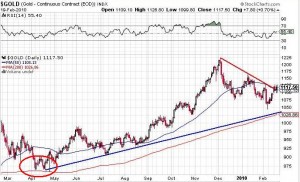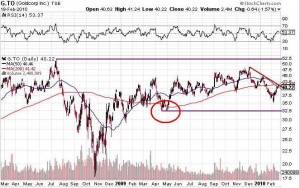Some days everything goes perfectly. Other days, not so much. A week or so ago I bought a few shares of RSW – Rydex Inverse 2X S&P ETF, on the expectation of further weakness. I think the market has been up every day since I bought RSW. Oh well, can’t win ’em all.
Sometimes I get lucky. My purchase of PBG.TO – Petrobank Energy and Resources Limited back on February 9 at $50.35 is looking good; it closed Friday at $54.69.
My trades on my gold portfolio were less than spectacular, unfortunately.
I came to the conclusion that with the massive up trend in the general markets over the last many months, we were due for a correction, and obviously this year the market has pulled back. Year to date the Dow is flat, but that’s only thanks to the rally over the last two weeks. My assumption was that general market weakness would lead to a weakness in precious metals stocks as well. I assumed this would be short term weakness, and I didn’t really want to sell my holdings, so I did some covered writing with options. As most of you are aware, you can sell call options on stocks you own. This is a strategy that works well if you like the stock and want to keep it, but also want to increase your returns.
For example, on February 4, 2010, with K.TO – Kinross Gold Corp. trading around $17.54, I sold the February 17 calls for $1.10 each. I assumed that with market weakness, Kinross would drop in price between February 4 and February 19, option expiry day (the third Friday of the month). Had that happened, I would still own my shares, and I would keep the $1.10 in premium I pocketed from selling the option.
Oops.
Despite some weakness at the end of the day on Friday, Kinross closed at $19.23, so my shares are gone. The holder of the calls will exercise their right to purchase my shares for $17, and I’ll get the $17, and I get to keep the $1.10, so in effect I sold my shares for total proceeds of $18.10, ignoring commissions. Unfortunately had I not sold the calls I could have sold the shares today for $19.23, so I lost $1.13 in the process.
I did the same with some of my shares of AEM.TO – Agnico-Eagle Mines Ltd.. I sold the February 54 calls for $2.50. Agnico-Eagle closed on Friday at $60.72, so my shares are gone for net proceeds to me of $56.50, instead of the $60.72 I could have made had I not covered, and waited until Friday, and then sold them. Looks like a bad decision, right?
Yes, this month it was a bad decision. But in January I did the same thing; I sold call options on AEM for 75 cents (they were out of the money, and close to the expiration date), and they expired worthless. So if you add that money to the pot, in effect my shares generated $57.25. That’s still a “loss” from the $60.72 I could have made, but not as bad as it could have been.
What’s the lesson here?
First, don’t do anything I do. Do the opposite, and you’ll do fine.
Second, if you want to pocket some cash by doing covered writes, you want the options to expire worthless, so you are best to sell options that are out of the money, and near expiration. That’s what I did in January, and they expired worthless. In February, I was selling calls that were at the money, or slightly in the money, so I generated a large premium ($2.50 in February, as compared to only 75 cents in January), but in the end I lost my shares because the price went up.
Third, I didn’t have to have my shares called. On Friday afternoon I could have simply re-purchased the options I sold. (Technically I “sold to open” when I sold them, so I would be “buying to close” this time). Had I done that, I would have lost money on the options, but I would still own the shares. So why didn’t I do that? Because I still expect some weakness in the shares over the next week or two, so it’s quite possible that I will be able to buy more shares at better prices.
And that’s exactly what I plan to do over the next week. I sold my shares in Kinross for the equivalent of $18.10, so I will place a bid at $18, or perhaps even lower. If I get filled in the coming week or two, I’m smart again, because I will end up with my shares, and my premium again. Is that likely to happen? Let’s look at some charts:
Gold may, or may not, have broken out of it’s consolidation since the peak at the beginning of December. My guess? We have one more test of the lows yet. We need a double bottom, to confirm the bottom, just like happened in the circled area on the chart, back in April and May. A drop back into the $1,050 to $1,075 range would represent a double bottom, and that will probably be our final buying opportunity, before gold resumes it’s rise. In other words, that’s when you back up the truck. I’m not convinced we are there yet.
As this chart of G.TO – Goldcorp Inc. shows, the previous consolidation ended with a double bottom, and we’ve been in a trading range ever since. I’m placing buy orders at $36 (with perhaps an additional order at $35, just in case in drops that far), and that’s where I’ll be buying, hopefully over the next few weeks.
So, to sum up:
I lost many of my gold shares today (technically options expire on the third Saturday of the month, not on the Friday, but I think in terms of Fridays), but I believe I can buy them back at less than the price I sold them for, so even though I’m heavily in cash, I’m not concerned. I haven’t lost anything, and if there is a pullback, I’ll be back in at good prices.
More on Physical Gold and Silver
The other reason I didn’t repurchase my options before the close on Friday was I was on the road, away from my computer. Every few months I make a trip to Scotia Plaza in Toronto, headquarters of Canada’s largest gold and silver bullion dealer, The Bank of Nova Scotia (today branded as Scotiabank). (You can read more in the How To Buy Physical Gold page). You can read about some of my previous trips in October 2008 and October 2009. In October 2008 there was a big shortage of physical gold and silver. I wanted to buy 100 one ounce silver Maple Leaf coins (total value $1,200) and they would only sell me 25. In October 2009 there were no shortages. This week, also no shortages, so physical supply has caught up with demand.
There was a line up when I arrived, but not a long one. It frustrates me that every transaction takes half an hour, since they have to manually fill out the purchase order, so if you ever go there, prepare to wait.
The guy beside me wanted to buy silver as a gift, so he ended up buying five silver Maple Leafs. A friend told him it was a good investment; why he didn’t do any actual research himself, I have no idea.
I asked about the prices for bars, instead of coins. Coins are easy to buy and sell, and they are divisible and easy to carry. Unfortunately in Ontario you must also pay 8% sales tax when you buy them, so the price is inflated by 8%. (Starting in July the new Harmonized Sales Tax increases that to 13%, so there goes the gold coin market). Bars carry no sales tax, and the premium is lower. On Friday a 100 ounce silver bar, all in, including commissions, was about $1,974 Canadian, or about $19.74 an ounce. That’s significantly cheaper than the $25.93 per ounce cost of a silver coin back in October 2009 (including taxes, in Canadian dollars).
A 20 ounce gold bar was quoted, all in, at $24,327 Canadian, or $1,216.36 per ounce Canadian. The exchange rate was 1.07, so in U.S. dollars that’s $1,136.79 per ounce. The spot price of gold closed yesterday at $1,117.50, and was as high as $1,126.80 on the day, so the bars were trading at a premium of around $10 per ounce, which considering commissions and exchange isn’t much.
On October 7, 2009 the spot price was around $1,045 US, and a one ounce gold Maple Leaf was $1,210 US, so obviously the premium on a coin is significantly larger than the premium on a bar. The premium over spot is $165, with the 8% sales tax on the coin representing $84 of the premium, leaving $81 per ounce in other premiums for buying a coin. A $10 premium on a bar looks pretty good.
So if you want small quantities that are easily transported and stored, buy coins. If you have lots of money and want to pay the cheapest price per ounce, buy bars.
I will spend some time this weekend calculating all of my stink bid prices to re-enter the market.
Before I go, how about that fake apology from Tiger Woods? I may screw up by selling options when I should be buying, but that pales in comparison to that guy. Here’s a great take on Tiger Woods and his fake apology.
But enough about Tiger; back to my calculations; see you next week.


{ 0 comments… add one now }
You must log in to post a comment.